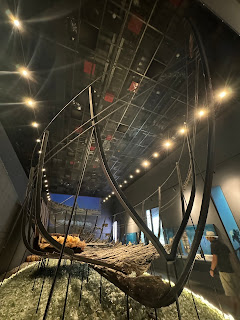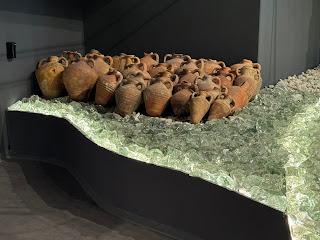The ancient city of Miletus, its name a whisper from the annals of history, awaited us. As we departed Kuşadası, the weight of time settled upon my shoulders. I felt dwarfed by the vast expanse of history, the rise and fall of civilizations echoing through the centuries. Babur, our guide, a custodian of the past, wove a tapestry of Miletus's glory, its ascent to prominence and its subsequent decline.
Miletus, a city of strategic significance, nestled at the mouth of the Meander River, had flourished as a commercial and cultural hub. Its shipbuilding prowess, its textile industry, and its intellectual pursuits had earned it a place of prominence in the ancient world.
The city's history was a tapestry woven with threads of conflict and resilience. The Persian Wars, a clash of civilizations, had left their mark on Miletus. The city, a beacon of resistance, had ultimately succumbed to the Persian Empire, yet its spirit remained unbroken.
Alexander the Great, a conqueror of empires, had cast his shadow over Miletus. Under his rule, the city had experienced a renaissance, its culture and commerce flourishing.
(The 9 of us on the land tour, there will be a sea tour coming up next…)
The echoes of ancient voices seemed to linger in the air, a haunting whisper from the past. The Theater of Miletus, a colossal structure, dominated the landscape, its tiered seating a testament to the city's architectural prowess. I could almost hear the screams of the crowd, the roar of their approval or disapproval. Babur, our guide, painted a vivid picture of the dramas, comedies, and spectacles that had once graced this stage. The theater, a vessel for the human spirit's expression,had witnessed the triumphs and tragedies of its time. Yet, there was a darker side to this story, a chilling reminder of the city's past. Early Christians, martyrs of their faith, had likely met their end within the confines of this arena, their blood staining the stones that now stood silent and serene.
As I walked the corridors of the theater, I couldn't help but imagine the emotions that must have coursed through the veins of the audience. The anticipation, the excitement, the shared experience of witnessing a performance – these were the echoes of the past that reverberated within the walls of the theater.
The journey continued, a pilgrimage through time. Miletus, its ancient echoes fading, gave way to the bustling port city of Bodrum. The sun, a relentless adversary, beat down upon us, a stark contrast to the cool respite of our hotel and the stone corridors of the theater. The marina, a testament to Turkey's maritime prowess, unfolded before us. Babur, our guide,painted a vivid picture of the shipbuilding traditions that had shaped this region, the gulets, graceful vessels born of human ingenuity and the sea's embrace.
Our journey led us to Bodrum Castle, also known as Castle of St. Peter, a fortress that stood as a sentinel over the city. Its massive stone walls, a testament to medieval might, offered a glimpse into the past. The museum, a treasure trove of history, revealed the secrets of the Aegean Sea.
As we wandered through the labyrinth of Bodrum Castle, the guided path led us to the tomb of the Carian Princess. This remarkable discovery, unearthed in 1989, offered a glimpse into the lives of the ancient elite.
The princess, a woman of mystery, had been laid to rest in a sarcophagus adorned with intricate carvings. Her skeleton, remarkably well-preserved, revealed a woman of stature and grace. The gold jewelry, the diadem, the lavish burial gifts – all spoke of her royal lineage.
Scholars delved into the artifacts, deciphering the clues they held. The date, a testament to the princess's era, was estimated to be between 360 and 325 BC. The analysis of her skeleton revealed her age, her height, even the fact that she had given birth. Her teeth, a testament to a life of privilege, were even and complete.
The princess, a figure shrouded in mystery, had been identified as Queen Ada, a member of the Hecatomnid dynasty that ruled Caria. The evidence, though circumstantial, pointed to her royal lineage. The two female busts, one found in the Mausoleum, the other in the Priene Athena Temple, bore a striking resemblance to the reconstructed face of the princess.
The Carian Princess, a symbol of the ancient world's opulence and power, had been brought to life. Her story, a testament to the enduring allure of history, continued to captivate and inspire.
The museum, a treasure trove of history, overwhelmed me with its vast collection of artifacts. Each piece, a fragment of the past, whispered tales of ancient civilizations.
The Uluburun shipwreck, a centerpiece of the museum, stood as a testament to the maritime prowess of the ancient world.Its cargo, a diverse array of goods, revealed the interconnectedness of civilizations.
Amphoras, vessels of commerce and culture, lined the shelves. Their shapes, their designs, offered a glimpse into the daily lives of the people who had used them.
Sculptures and statues, frozen moments in time, depicted the gods, the heroes, the ordinary citizens of the ancient world. Their artistry, a testament to human ingenuity, transported me back to a bygone era.
Jewelry and artifacts, each a story unto itself, revealed the intricacies of ancient life. The coins, a currency of the past, bore witness to economic transactions. The jewelry, adorned with precious stones and intricate designs, spoke of opulence and beauty.
Anchors, relics of the sea, stood as silent guardians of the museum. These tools of navigation, forged in the fires of ancient craftsmanship, offered a glimpse into the maritime traditions of the past.
The Museum of Underwater Archaeology, a treasure trove of history, paid tribute to the sponge divers, unsung heroes of the Aegean Sea. These men, their courage a testament to the human spirit, ventured into the depths, armed with nothing more than a knife and a basket. The sea, a treacherous mistress, claimed many lives, yet the allure of the sponges, prized for their absorbent qualities, drew them back time and again.
The museum, a testament to their legacy, showcased the improving tools of their trade, the simple implements that had aided them in their perilous pursuits. Artifacts recovered from their underwater explorations, a testament to their discoveries, were displayed with reverence.
The Serçe Limanı Glass Wreck, a treasure trove of history, offers a glimpse into the maritime world of the 11th century AD. Discovered in 1977, this shipwreck has yielded a wealth of artifacts, including glass vessels, ceramics, tools, and personal belongings. I find it fascinating one could still touch these crystal from more than a thousand years ago. This wreck provides valuable insights into the trade routes, shipbuilding techniques, and cultural practices of the time.
Just outside the museum, a bronze bust stood as a tribute to Cevat Şakir Kabaağaçlı, a towering figure in Turkish literature. As I gazed upon his likeness, I couldn't help but feel a sense of reverence for this man who had so eloquently captured the essence of Bodrum. I made a mental note to delve deeper into his writings, to experience firsthand the magic of his prose.
As we made our way back to the van, the echoes of history still ringing in our ears, I engaged in conversation with Babur. He recounted a tale of Diogenes, a philosopher of ancient Greece, and his encounter with Alexander the Great.
The anecdote, a testament to Diogenes' unconventional wisdom, painted a vivid picture of the encounter. Alexander, a conqueror of empires, had approached Diogenes, a man who lived in a barrel, his possessions reduced to the bare essentials. The king, impressed by Diogenes' simplicity, had asked if there was anything he could do for the philosopher.
Diogenes, unfazed by the king's power and authority, had replied with a single, profound statement: "Step aside, you are blocking the sunlight." The words, a challenge to the conventions of the time, had left Alexander speechless. Diogenes, in his simplicity, had offered a profound critique of the pursuit of power and wealth.
The tale, a testament to Diogenes' wisdom and courage, ignited a spark within me. I made a mental note to explore his writings, to understand the mind of a man who had dared to question the status quo.
We arrived at the Salmakis Resort, exhausted and sun-kissed, I retreated to our room, seeking respite from the day's adventures. Soon, it’s dinner time and the sun dipped below the horizon, casting long shadows across the landscape, a sanctuary of tranquility amidst the bustling city.
The town, a siren song beckoning us to explore, was reluctantly abandoned. Our bodies, weary from the day's exertions, demanded rest. A short stroll around the hotel grounds, a gentle exploration of the immediate surroundings, sufficed. As darkness enveloped the resort, iPhone in hand, I try to capture the night's ethereal beauty.
































































No comments:
Post a Comment